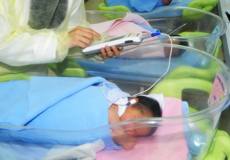Hearing loss is the most common birth defect and prior to the development of Universal Newborn Hearing Screening Programs the average age at which these children were identified was around three years and with milder hearing losses commonly remaining undetected until a child had entered elementary school. The implications of this delay in detection are dramatic. Most developmental milestones for language occur within the first year of life, and if they pass without intervention they will almost certainly result in lifelong deficits in speech and language. In addition, infants who are not identified with hearing loss early will likely experience delays in other facets of life; these include social and emotional development as well as cognitive and academic growth.
In response to such facts the UNHS program in KAMC, Riyadh was initiated on April 17,2010 following the approval of establishing the Universal Newborn Hearing Screening Program in February 22,2010 with Resolution # 05-02 (02-10). This resolution mandates providing hearing screening for all newborns in well-baby nursery prior to discharge.
The screening was done in the nursery by trained personnel, staff nurse, supervised by an audiologist. The machine used is one Echo-screen that includes both AOAE (ATOAE & DAOAE) and AABR. All newborns who completed the screening stages and who finally refer AABR are given an appointment for re-screening in the audiology clinic. The screening was done either bedside or in a quite room if the environment is noisy. The screening is performed every day including weekends.
Mission Statement
The mission of the Universal Newborn Hearing Screening Program in KAMC is to support early identification and timely and appropriate intervention for all newborns with hearing loss in an effort to prevent speech, language and other delays and support children in reaching their maximum potential.
Goals

The hearing of every newborn should be screened prior to hospital discharge and those who do not pass the screening and the re-screening after discharge as an outpatient should receive an appropriate audiological diagnostic evaluation by the age of three months and those who diagnosed with hearing impairment as a result of the UNHSP are referred to appropriate intervention resources by six months of age.
A proper data management system to trace and to document the number of newborns screened, number of newborns who pass & refer in hearing screening, number of newborns who pass & refer in hearing re-screening, infants with confirmed hearing loss, and infants who referred to early intervention services.
 Risk Factors for Hearing Loss at Birth
Risk Factors for Hearing Loss at Birth
Family history of hereditary childhood sensorineural hearing loss
In utero infections (toxoplasmosis, rubella, cytomegalovirus, herpes simplex virus infection, syphilis)
Craniofacial anomalies
Birth weight <1500 g.
Hyperbilirubinemia requiring exchange transfusions
Ototoxic medications (aminoglycosides alone or in combination with loop diuretics)
Bacterial meningitis
Postnatal asphyxia (Apgar <5 at 1 min. or <6 at 5 min)
Mechanical ventilation lasting 5 days or longer
Stigmata associated with syndrome associated with hearing loss.
Screening Techniques
Before discharge “as an inpatient” screening with Echo-screen machine and that includes;
Automated Oto-acoustic Emissions (AOAE) including; Automated Transient Oto-acoustic Emissions (ATOAE) and Automated Distortion Product Oto-acoustic Emissions (ADPOAE).
Automated Auditory Brainstem Response (AABR). No interpretation is required for both of AOAE & AABR since the device is fully automated and elicits only pass/refer responses. If the newborn passes the screening in both ears no further appointments are needed but if the newborns refer in one or both ears an appointment with the re-screening clinic will be given.
After discharge “as an outpatient” re-screening procedure and that includes;
Click Auditory Brainstem Response (ABR)
If normal bilaterally without a family history of hearing loss Discharge
If abnormal Give another appointment to repeat ABR “AC ABR, BC ABR, Tone Burst ABR if needed”, refer to pediatric otolaryngologist, & start the early intervention protocol for confirmed hearing loss.
Early Intervention Services
Infants identified with any kind of hearing loss are referred by the audiologist to ENT for medical management.
Intervention will be started as soon as possible with the appropriate hearing device.
The results of the hearing assessment, counseling regarding the important of early intervention and the recommendations for the most suitable intervention strategy will be discussed with the caregivers.